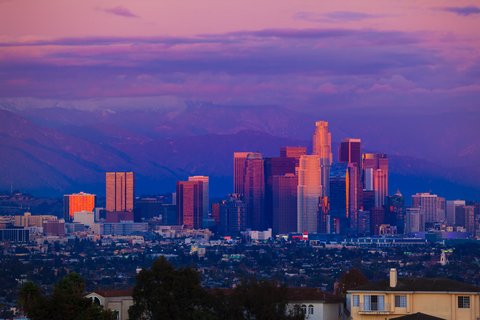A debate is raging over one of California’s greatest cities. Los Angeles is at risk of decline, according to a report published by the Los Angeles 2020 Commission. The report’s first paragraph reads:
“Los Angeles is barely treading water while the rest of the world is moving forward. We risk falling further behind in adapting to the realities of the 21st century and becoming a city in decline.”
The report’s opening salvo does make a bold and convincing statement. Here are some highlights:
- 28% of working Angelinos earn poverty-level pay — L.A. boasts the highest poverty rate of any other major metropolitan area in the U.S.;
- median income in L.A. is lower than it was in 2007;
- L.A. has lagged behind the rest of the nation in job creation since 1990, showing a net decline in non-farm employment over the last decade;
- L.A. is strangled by traffic;
- its public school system is failing; and
- city pension programs are sucking their coffers dry.
The list goes on and on. As someone who lives in and loves Los Angeles, I can tell you it is heartbreaking to read this list.
Many Angelinos, including Mayor Eric Garcetti, have criticized the apparent pessimism of the report. They no doubt fear the negative public relations spiral that is bound to happen when a distinguished group of leaders get together and slam their own city.
In truth, the report does read as rather bombastic. Many of the “facts” go un-cited and the authors have a tendency to link quantitative data to very subjective categories with statements like, “40% of our community lives in what only can be called misery” — hardly a technical term.
One economic topic conspicuously absent from the report is real estate. When the New York Times picked this story up, they quickly identified this disparity, saying:
“From the 73-story skyscraper that just broke ground downtown (the tallest in the West), to the blizzard of office, shopping and apartment complexes rising from there to the Pacific, construction is bustling in Los Angeles. Home prices are up, and the foreclosure rate is declining.”
There’s good reason for these opposite economic perspectives on L.A. The city, as is the case throughout California and indeed the country, is becoming a classic barbell economy.
A barbell economy is one in which the middle-wage jobs are emptied out of the equation and the economy becomes increasingly polarized with high-wage, high-skill jobs on one end of the spectrum and low-wage, low-skill jobs on the other.
The withering away of the American middle class is not a new concern. So many of the solutions proposed have to do with protecting the jobs the middle class currently have, which is usually the work of labor unions and moderate liberal politicians.
What the middle and lower classes need is a rapid increase in education and skills to level the playing field and give way to a paradigm shift.
Many of the jobs that we now consider high-skill and high-wage would become the norm. In this era of rapid technological growth and the global outsourcing of manual labor jobs, the solution is not to bring manufacturing back to California. We must sufficiently educate the class of people who would otherwise be stuck in these jobs so they may join the upper echelon and slowly render it the comfortable middle once again.
We often say that jobs drive real estate. Well perhaps we ought to argue that education drives real estate, especially financial literacy, since it is the bedrock of any future job that will pay wages sufficient for saving a down-payment and servicing mortgage debt on a piece of California property.



















While it is encouraging and pleasant to think that those who lose high paying labor jobs (like auto workers and other factory workers) can be “re-educated” to man high tech jobs, the reality is not so pleasant.
In the eastern U.S., in former manufacturing hubs, hundreds of thousands of men and women who held high paying labor jobs (and thus, were solidly middle class income-wise) were displaced when their factories either closed down or moved overseas, thanks to corporate greed. Look at the result. Most cities that lost their manufacturing base either descended into “Rust Belt” status or decayed like Detroit, and thousands of their formerly well-employed citizens either moved West or elsewhere looking for work, went on the dole, or dropped out of the labor force entirely.
Anyone who believes you can take most factory workers and magically educate them to do high tech jobs is living in fantasy land. Pittsburgh, Pennsylvania is a case in point. Its former workers in heavy industry did not up their education to become high tech workers, but became unemployed or took low paying service sector jobs. Pittsburgh did successfully transform itself from a grimy mill town to a high tech hub, but it is not the former heavy industry laborers doing the high tech work. It is highly educated persons who came into the area from elsewhere or younger persons who moved through the educational system in time to catch the wave of new jobs.
Most of the small cities in the Ohio Valley were not so lucky. They are shadows of their former selves. Population loss has eroded their tax bases and the numbers of persons on public assistance or unemployment has risen dramatically.
The middle class in America is being destroyed by the greed of banks and corporations concerned only with making elite bankers and corporate CEOs rich, not upholding the American dream for millions of middle class citizens.
Trickle down is a false concept. The corporations are sitting on over $2 trillion in cash, yet 800,000 more Americans just departed the labor force out of sheer frustration, unable to find suitable work (which, by the way makes the latest unemployment figures put out by the government totally deceiving). The true rate of unemployment in America is at least 16% and probably 20% in some age groups.
The Great Recession never ended folks. They just told you it did. Did you believe them? Remove the self-serving central bankers from power and reclaim prosperity for America.
This is all a result of Our immigration policy over the last 30 years.Of coarse the perks that go to low income “aliens’ residents is the strongest incentive for foreign citizens who want to come to the land of the free. The voters of America have sold themselves out to Leftist control. I support Convention of the states to get their heads together. A lot of things need to change before our real estate market can stabelize